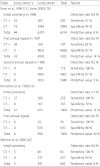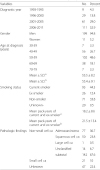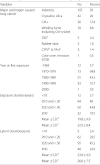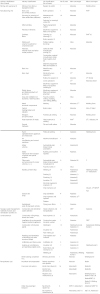2. Tossavainen A, Huuskonen MS, Rantanen J, Lehtinen S. Asbestos, asbestosis, and cancer. Proceedings of the International Expert Group Meeting, Helsinki FIOH. People and Work, Research Reports 14; 1997.
3. Tossavainen A. Asbestos, asbestosis, and cancer: the Helsinki criteria for diagnosis and attribution. Consensus Report. Scand J Work Environ Health. 1997; 23:311–6. DOI:
10.5271/sjweh.226. PMID:
9322824.
4. Gustavsson P, Jakobsson R, Nyberg F, Pershagen G, Järup L, Schéele P. Occupational exposure and lung cancer risk: a population-based case referent study in Sweden. Am J Epidemiol. 2000; 152(1):32–40. DOI:
10.1093/aje/152.1.32. PMID:
10901327.
5. Gustavsson P, Nyberg F, Pershagen G, Schéele P, Jakobsson R. Low-dose exposure to asbestos and lung cancer: dose-response relations and interaction with smoking in a population-based case-referent study in Stockholm, Sweden. Am J Epidemiol. 2002; 155(11):1016–22. DOI:
10.1093/aje/155.11.1016. PMID:
12034580.
6. IARC. Asbestos. IARC Monographs on the Evaluation of Carcinogenic Risk of Chemicals to Humans, vol. 14. Lyon, France: International Agency for Research on Cancer; 1977. p.106.
7. IARC. Asbestos. In Overall Evaluations of Carcinogenicity. IARC Monographs on the Evaluation of Carcinogenic Risk of Chemicals to Humans, suppl 7. Lyon, France: International Agency for Research on Cancer; 1987. p. 106-116.
8. National Academy of Sciences. Asbestos: Selected Cancers. The National Academies, Institute of Medicine, Board on Population Health and Public Health Practices, Committee on Asbestos: Selected Health Effects. 2006. Washington, DC: The National Academies Press;p. 340.
9. Straif K, Benbrahim-Tallaa L, Baan R, Grosse Y, Secretan B, El Ghissassi F, et al. A review of human carcinogens—Part C: metals, arsenic, dusts, and fibres. Lancet Oncol. 2009; 10(5):453–454. DOI:
10.1016/S1470-2045(09)70134-2. PMID:
19418618.
14. Parker J. Radiological criteria: the use of chest imaging techniques in asbestos-related diseases. Proceedings of an international expert meeting on asbestos, asbestosis and cancer. 1997. Helsinki: Finnish Institute of Occupational Health, People and Work Research Reports.
16. Sone S, Li F, Yang Z, Honda T, Maruyama Y, Takashima S, et al. Results of three-year mass screening programme for lung cancer using mobile low-dose spiral computed tomography scanner. Br J Cancer. 2001;84(1):25.Available from:
http://www.ncbi.nlm.nih.gov/pmc/articles/PMC2363609/ Accessed date April 2013.
17. Tossavainen A. International expert meeting on new advances in the radiology and screening of asbestos-related diseases. Scand J Work Environ Health. 2000; 26(5):449–454. DOI:
10.5271/sjweh.567. PMID:
11103845.
18. Sone S. Lung cancer screening using mobile low-dose computed tomography: results from Nagano project in Japan. In: Proceedings of an international expert meeting on new advances in radiology and screening of asbestos-related diseases. Helsinki: Finnish Institute of Occupational Health, 2000:3346. People and Work Research Reports, no 36.
19. Henschke C, McCauley D, Yankelevitz D, Naidich D, McGuinness G, Miettinen O, et al. Early Lung Cancer Action Project: overall design and findings from baseline screening. Lancet. 1999;354(9173):99-105.
20. Vehmas T, Kivisaari L, Zitting A, Mattson K, Nordman H, Huuskonen M. Computed tomography (CT) and high resolution CT for the early diagnosis of lung and pleural disease in workers exposed to asbestos: Finnish experiences. In: Proceedings of an international expert meeting on new advances in radiology and screening of asbestos-related diseases. Helsinki: Finnish Institute of Occupational Health, 2000:53-6. People and Work Research Reports, no 36.
21. Al-Jarad N, Strickland B, Pearson MC, Rubens MB, Rudd RM. High resolution computed tomo- graphic assessment of asbestosis and cryptogenic fibrosing alveolitis: a comparative study. Thorax. 1992;47(8):645-50. Available from:
http://thorax.bmj.com/content/47/8/645. Accessed date April 2013.
22. Akira M, Yamamoto S, Inoue Y, Sakatani M. High-resolution CT of asbestosis and idiopathic pulmonary fibrosis. Am J Roentgenol. 2003;181(1):163-9.Available from:
http://www.ncbi.nlm.nih.gov/pubmed/12818850. Accessed date April 2013.
24. Douglas W. Hehderson, Klaus Ro Delsperger, Hans-joachim, Woitowitz, James Leigh. After Helsinki: a multidisciplinary review of the relationship between asbestos exposure and lung cancer, with emphasis on studies published during 1997-2004. Pathology. 2004;36(6):517-50. Available from:
http://www.tandfonline.com/doi/abs/10.1080/00313020400010955#.VmPcTZuwecw. Accessed date May 2013.
30. Bailar JC, Buseck PR, Coleman RG, Frank A, Herrick RF, Kelsey KT, et al. Asbestos: Selected Cancers. Committee on Asbestos. Washington (DC): National Academy Press; 2006.
34. Acheson ED, Gardner MJ, Pippard EC, Grime LP. Mortality of two groups of women who manufactured gas masks from chrysotile and crocidolite asbestos: a 40-year followup. Br J Ind Med. 1982;39:344-8. Available from:
http://oem.bmj.com/content/39/4/344.short. Accessed date June 2013.


















 PDF
PDF Citation
Citation Print
Print


 XML Download
XML Download